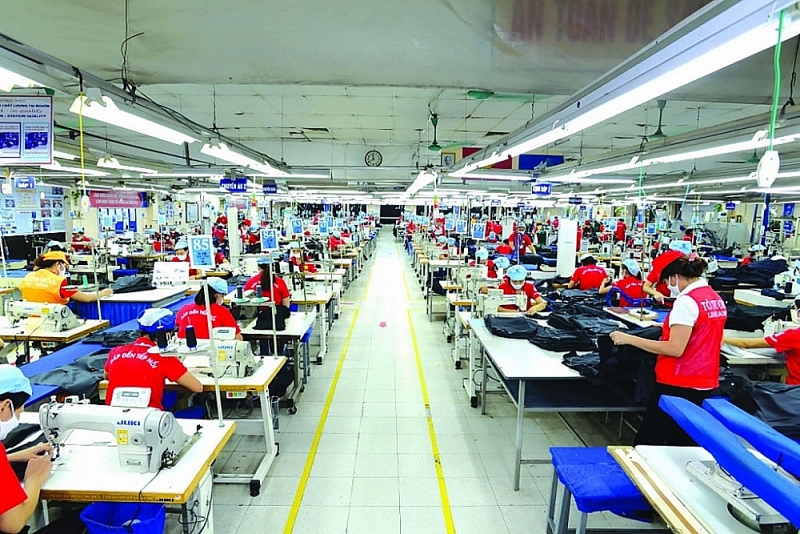 |
| Allocating and classifying possible risks is one way that May 10 minimizes risks in international trade. Photo: N. Thanh |
More and more risks
Assessing this issue, Mr Nguyen Cong Cuong, Vice Chairman of the Hanoi Association of Key Industrial Products Manufacturers (HAMI), said that Vietnam currently has strengths in import and export. In the last 2 years, despite being affected by the Covid-19 epidemic, imports and export still grew, but when the playing field expanded, it meant more risks and trade disputes. A recent example is the loss of the original documents of 76 cashew containers of 5 Vietnamese export enterprises to Italy. Up to this point, the matter of 76 containers of cashew nuts has been resolved, but it is also a lesson for businesses in the cashew industry in particular and export enterprises of Vietnam in general.
Mr Nguyen Cong Cuong said that according to the US-based Global Association of Anti-Fraud Professionals, global businesses lose about 5% of their revenue each year because of fraud. The average value of a scam is $1.7 million. A survey by the Vietnam Confederation of Trade and Industry (VCCI) also showed that globally, the proportion of businesses that were victims of fraud and economic crime in 2018 was 49%, 47% in 2020 and 46% in 2022. Fraud from outside accounts for about 43%; internal 31%; collusion between inside and outside accounts for 26%.
Sharing his experience in dealing with risks in international trade, Mr Bach Thang Long, Standing Deputy General Director of Garment 10 Corporation, said that to ensure safety in export production and business activities, May 10 has selected large markets in developed economies such as the US, UK, Germany, France, Japan, Australia, Korea… who own large market sizes and strong and flexible financial systems. In addition, enterprises always attach importance to and prioritize the production and export of garment products to countries with bilateral free trade agreements so that customers can enjoy tax incentives and get more competitive prices. As a result, the company can build customers’ trust and get more orders.
With a large production scale, May 10 does not focus on 1 or 2 large customers but on many large ones instead, allocating and dividing risks that may occur in case one of its partners is in trouble or under financial risks like bankruptcy. Currently, May 10 has about 30 different customers with many product categories and many big brands.
Regarding payment terms, Mr Bach Thang Long shared his experience selecting highly secured international payment methods such as a letter of credit L/C and prepayment through reputable large credit institutions and banks. For imported raw materials, they should combine with checking all payment information inspection solutions (especially first-time payments) from suppliers from China, India, Taiwan, and Hong Kong Kong (China), for example: for the first payment, it is necessary to check the bank account numbers of the suppliers in the following forms: direct call, fax, live chat software, via nominated customers/guarantee to order raw materials to ensure safety before payment. In particular, May 10 has a department to compile statistics on information related to international payment risks in international trading transactions.
Businesses still lack experiences
Also analyzing risks in export, Mr Tran Thanh Quyet, Executive Director of the Italian Chamber of Commerce in Vietnam (ICHAM), said that the biggest challenge of Vietnamese enterprises today is that they do not have much experience in preventing and dealing with fraud and disputes that are very likely to occur. In addition, many businesses are unfamiliar with the business culture of each country, unfamiliar with partners, and lacking awareness of the dispute resolution agencies and dispute resolution procedures.
In addition, many businesses are unfamiliar with common forms of commercial dispute resolution, such as commercial arbitration and commercial mediation. As a result, many businesses still rarely use lawyers regularly for advice during contract drafting or commercial dispute resolution.
Notably, when bringing products to foreign countries, many businesses have had trademark disputes resulting in not being protected in that country. The reason is that the enterprise failed to register for protection in that country, leading to the loss of its trademark in the international market. For example, the Trung Nguyen coffee brand was registered in advance by a company in the US. After 2 years of negotiation, the company in the US also returned the protection rights and accepted to be the distribution agent for Trung Nguyen coffee products from Vietnam in the US. Or Phan Thiet fish sauce has been trademarked by a company in the US since 1999. Vinataba Vietnam’s tobacco brand has been appropriated by an Indonesian company and registered in China, Japan, Korea and 9 countries in ASEAN.
To avoid commercial risks, according to Mr Tran Thanh Quyet, businesses need to carefully check their partners, study the regulations on the origin and market characteristics; apply for trademark registration; take careful consideration in international payment; establish an information network, regularly contact the Trade Office, the Chamber of Commerce and other supporting organizations and especially need to build a habit of using legal services.
According to Ms Dam Viet Anh, Director of 911 Group Joint Stock Company, risks may exist in issues related to currency, policies and laws, transportation activities, delivery time and reliability of goods, solvency and language risk. With the experience of 911 Group, Ms Dam Viet Anh emphasized 8 notes in making international trade: do market research; build good relationships with partners; be careful in negotiating contracts; ready to deal with credit risks; strictly supervise cost control; regularly monitor and evaluate the market and use insurance tools.
